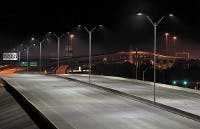Outdoor Lighting: Cree supplies LEDs to Baytown; 'Street Fight'; San Francisco
Cree has announced that Baytown became the first city in the state of Texas to light freeways with LED fixtures mounted on double-arm 54-ft poles spaced at 270 ft. The company also announced the new LEDway High Output (HO) family that extends maximum output to 26,800 lm, enabling easy retrofit of 400W HID fixtures. Caltrans, meanwhile, is installing LED lighting on the new eastern span of the San Francisco, California Bay Bridge. The Rocky Mountain Institute has published a blog post on streetlights and the solid-state lighting (SSL) transition that calls into question utilities' motivation and also looks forward to how networked streetlight systems may evolve.
Baytown, Texas
Baytown, located just east of Houston, worked with the Texas Department of Transportation (TxDOT) on the freeway project that includes Interstate I10, the 330 spur, and State Highway 146. First the city performed a trial monitoring the light output of six 400W high-pressure sodium (HPS) fixtures over the course of three months and then replacing them with Cree LED fixtures and taking similar measurements. The test program that was initiated in 2010 led the city and TxDOT to choose SSL for the larger lighting project.
Both potential energy and maintenance savings factored into the decision-making process. TxDOT had data that showed relamping cost of HPS lighting along freeways to be $130 to $150 with the actual cost to a municipality even higher due to added labor costs. Moreover, the typical HPS light on a freeway must be relamped every two years. Patti Jett, public affairs coordinator for Baytown, said, "The cost savings have directly offset other important budgetary items, while reduced maintenance needs allow staff to work on other projects city-wide. The lighting upgrade has certainly impacted taxpayer dollars in a very positive way."
The lighting retrofit, however, has also delivered improved light quality. The city said that law enforcement agencies have indicated the SSL installation has created a safer nighttime environment and that other motorists have commented about the enhanced visibility and elimination of shadows.
LEDway High Output
While the Baytown installation uses the Cree LEDway SeriesE products that top out at around 24,000 lm, Cree has just announced the LEDway HO series with slightly higher output. Moreover, the HO line uses the larger LEDs and one-piece optics initially brought to market in the XSP line of products in April 2012. By molding all of the total internal reflection (TIR) lenses into one piece, Cree was able to reduce the price of the streetlights. Indeed, the same technology is used in the sub-$100 XSPR street light that is designed for residential applications.
The new HO family also includes the ability for a municipality to adjust the light output at installation time and precisely match the light level required for a specific installation. Users can set the lights to as little as 60% of full scale and realize commensurate energy savings while enjoying the logistical benefits of stocking a single product for usage in different conditions with varying pole spacing and mounting heights. We have a more detailed description of the usage scenario in a LEDway HO article on our Illumination in Focus website.
Street Fight
Despite the benefits of LEDs for streetlighting, not everyone is on board with SSL technology. Some utilities still view the SSL transition as a movement that could reduce the revenue stream they enjoy from owning and powering streetlights and charging municipalities for energy used on a flat-rate basis and for maintenance. The Rocky Mountain Institute (RMI) detailed the conundrum on its RMI Outlet blog in a post entitled "Street Fight".
RMI's mission is to "drive the efficient and restorative use of resources" and the blog post notes that some utilities aren't necessarily on board with many cities' desire to assume ownership of their streetlight inventory and pocket the savings. Moreover, the ongoing movement to network streetlights could result in even more opportunity for new services including data networking services available to the public.
The authors speculate that the computer networking industry may ultimately get involved and mentioned networking stalwart Cisco specifically by name. At the 2014 Strategies in Light show, scheduled for February 25–27 in Santa Clara, California, Cisco business development manager Matt Laherty will present a talk entitled "Light as a service" so the company clearly has its eye on the potential for participation in the SSL transition. Back to the blog, it's a very interesting read.
San Francisco Bay Bridge
In San Francisco, the California Department of Transportation (Caltrans) is using LED lighting to create a cathedral-like aesthetic for the new eastern span of the Bay Bridge. The San Francisco Chronicle reports that LED fixtures costing in the range of $2 million have been installed on the suspension cables but that the main tower remains too dark and more lights will be added to the project.
Howard Brandston handled the lighting design and was previously responsible for lighting the Statue of Liberty. The custom fixtures were made by Musco Lighting. Previously the western span of the bridge was lit as the centerpiece of The Bay Lights Project with dynamic control of Philips Color Kinetics fixtures and programming by artist Leo Villareal. But that project was paid for by private funds.






